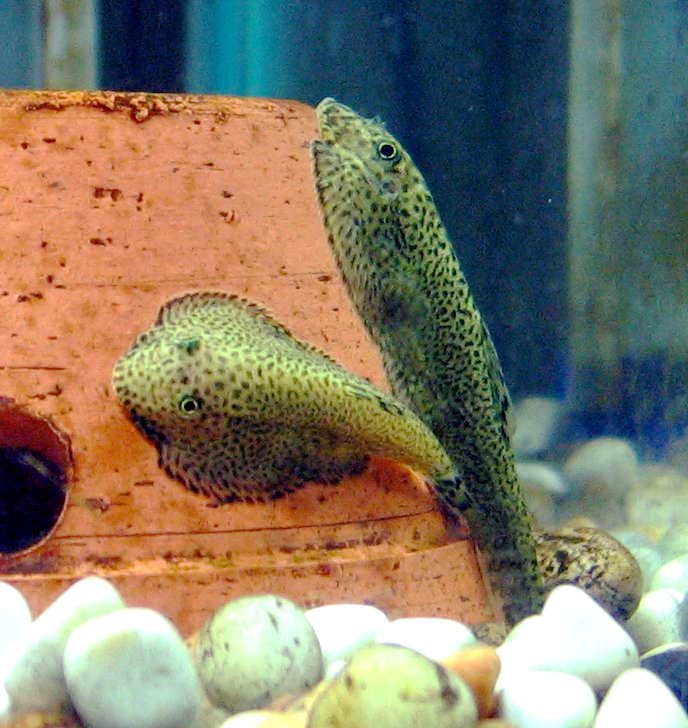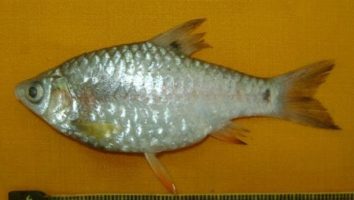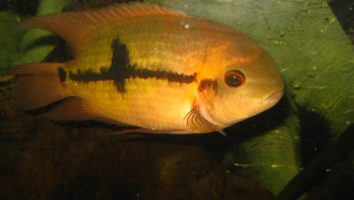The butterfly hillstream loach is a striking freshwater fish that is relatively easy to care for.
As their name suggests, these fish come from fast-moving streams in Asia where they cling to rocks and eat algae.
In the aquarium, they will do best in a setup that replicates their natural habitat as closely as possible. This means a tank with plenty of flow and hiding places amongst the rocks.
Butterfly loaches are a peaceful community fish but can be shy, so they should be kept in a group of at least 5.
This guide will teach you everything you need to know about butterfly loach care.
Table of contents
Species overview
Butterfly hillstream loaches (scientific name: Sewellia lineolata) are a type of freshwater fish that is native to various parts of China and Vietnam.
They prefer habitats with a lot of rocks and hiding places, as well as a moderate to high flow of water. This is something to keep in mind when setting up their tank.
Butterfly hillstream loaches are omnivores, so they will eat a wide variety of food. However, they do have a preference for live food, so including this in their diet is a good idea.
These fish are relatively small, so they are a good choice for nano aquariums. They are also a peaceful fish, which makes them a good tank mate for a variety of other species.
Appearance

The Butterfly hillstream loach is a very small freshwater fish that is easily recognizable thanks to its long and slender body.
These fish have a brown or black base color with white spots all over their body. The spots are more prominent on their fins and tail.
The fins on the Butterfly hillstream loach are all very thin and delicate. The dorsal fin is the longest and starts about two-thirds of the way back on the fish.
The caudal fin is forked and extends back almost to the end of their bodies. The anal and pectoral fins are both shorter than the dorsal and caudal fins.
These fish have a very long and thin body that tapers off at the end. They have a rather small head in comparison to the rest of their body.
The eyes on the Butterfly hillstream loach are large and protrude slightly from their head. They have a small mouth that is located at the bottom of their head.
Lifespan
Butterfly hillstream loaches have a lifespan of 3-5 years.
The biggest factor impacting their lifespan is water quality. These fish are very sensitive to changes in water parameters and even small fluctuations can be deadly.
Another factor that can impact their lifespan is diet. In the wild, these fish feed on a variety of small insects and crustaceans. If they don’t have a diet that mimics this in captivity, they may not live as long as they otherwise could.
Size
Butterfly hillstream loaches only grow to be about 3 inches long.
Tank
Tank Size
The minimum tank size for hillstream loaches is 20 gallons. If you want to keep more than one fish, you should add at least 10 gallons for each additional fish.
Water Parameters
Butterfly hillstream loaches are a freshwater fish that is native to fast moving streams and rivers in Southeast Asia. In the wild, they can be found in countries such as Thailand, Laos, Cambodia, and Vietnam.
The water parameters that they need are as follows:
- Water temperature: 64-75 degrees Fahrenheit
- pH levels: 6.0-8.0
- Water hardness: 2-12 dGH
- Alkalinity Levels: 4-8 dKH
What To Put In Their Tank
The setup for a Butterfly hillstream loach aquarium is actually pretty simple.
First, you need to choose the right size tank. They’re not the biggest fish out there, but you still need at least a 20-gallon tank for a single fish. If you want to keep more than one then you need to increase the size of the tank accordingly.
As for the substrate, you can go with either sand or gravel. They’re not too picky when it comes to this. Just make sure that the gravel isn’t too big.
These fish love to hide, so you need to provide them with plenty of places to do so. Driftwood, rocks, and caves are all great options. Just make sure that the caves aren’t too small or the fish might get stuck.
Plants are a little trickier. They’re not known to eat plants, but they will uproot them when they’re looking for a place to hide. If you want to include plants then we recommend something that’s very sturdy (like Java Fern).
You also need to make sure that the inside of their tank is well-oxygenated. They come from fast-moving waters so they’re used to a lot of oxygen. A good filter will help with this, but you can also add an air stone if needed.
Common Diseases
These fish are actually quite hardy and don’t fall ill often. However, there are a few diseases that you should be aware of, just in case.
The first one is white spot disease, which is also known as ich. This is a very common freshwater disease that can affect Butterfly hillstream loaches (and really any other fish species).
The most obvious symptom of this disease is the presence of white spots on the body, fins, and gills of your fish. If you notice this, it’s important to act quickly and consult your vet.
The second disease to be aware of is gill flukes. This is a parasitic infection that can cause a lot of problems for your fish. The most common symptom is excessive mucus production, which can make it hard for your fish to breathe.
If you notice this, it’s important to take your fish to the vet as soon as possible. They will be able to give you the proper medication to treat the infection.
Behavior & Temperament
Butterfly hillstream loaches are peaceful fish that get along well with other similar species. They are relatively shy, so they may not be the best fish for an aquarium with a lot of activity.
Butterfly hillstream loaches are active fish that enjoy swimming in groups. They are constantly on the move, so they need a lot of space to swim. They also need an aquarium with plenty of hiding places.
These fish are known for their unique “butterfly” markings. They are black with white spots that are arranged in a butterfly-like pattern.
Tank Mates
These fish are best kept in groups of 5 or more. They’re social creatures that do best when they have their own kind around.
As for tank mates, the options are endless. Butterfly hillstream loaches are peaceful fish that get along with just about everyone.
The only thing to keep in mind is that these fish come from fast-moving waters. As a result, they need high levels of oxygenation.
This means you need to either have a very large tank or choose tank mates that don’t occupy the same water column.
Some compatible Butterfly hillstream loach tank mates include:
- Guppies
- Tetras
- Barbs
- Rainbows
- Danios
- Corydoras
- Plecos
Breeding
Butterfly hillstream loaches are not easy to breed in captivity. They are a species that is best left to the experts.
If you’re determined to breed them, you’ll need to set up a specialized breeding tank. The tank should be at least 30 gallons and should have a strong current.
You’ll also need to create a spawning mop. This can be done by tying some yarn around a rock. The yarn will need to be long enough to reach the bottom of the tank.
When the tank is set up, add the male and female butterfly hillstream loaches. The female will lay her eggs on the spawning mop. Once she has done that, the male will fertilize them.
After about a week, the eggs will hatch. The fry will be very small and will need to be fed live food.
This species is very difficult to breed and the fry are very delicate. It’s best to leave them to the experts.
Conclusion
Butterfly hillstream loaches are a great addition to any freshwater aquarium. They’re relatively easy to care for and add a lot of visual interest to your tank with their vibrant colors and interesting patterns.
They’re also peaceful fish that get along well with other community fish, which makes them a great option for beginners and experienced fishkeepers alike.
Overall, we think they’re a great fish and we highly recommend them!












